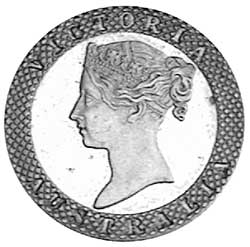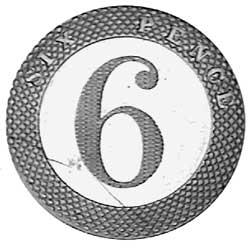Patterns & Proofs


Lot 3163 Patterns & Proofs
Estimate $8,000
Bid at live.noble.com.au
SOLD $11,100
PORT PHILLIP, Kangaroo Office pattern sixpence in silver by W.J. Taylor, (c.1855), plain edge (2.774 grams), an issue of a maximum of 10 pieces. Brilliant proof, with very light marks, otherwise FDC and extremely rare.
Ex Spink Stern Auction Sale October 30, 1975 (lot 73) and believed to be from either S. Hagley or J. Gartner Collection (R.Jewell) and J. Smith Collection. Forrer in 'The Biographical Dictionary of Medallists' cited by John Sharples (NAA Journal Vol.4 p.31) states 'in November 1852, (W.J.) Taylor sent out a coining press and complete plant to Melbourne (actually it was more like October-November 1853). The undertaking was financed by a small syndicate, and Mr. W.R. Scaiffe was in charge....Dies for Port Philip gold pieces of 1853 and Victorian shilling and sixpence of the same time were probably made by Taylor and sent out ..... Taylor's plan to mint gold into pieces stamped and of convenient weight fell through because by the time his mint was ready the banks were buying gold at full value. The press was bought by Mr. Thomas Stokes in 1857.' Sharples further states that the Kangaroo Office was trying to make a profit and this was to be achieved by purchasing cheap gold on the fields and then releasing it at full value in token form. However with delays the press was ready by late June or early July 1854 (Sharples p.33). Taylor had dies made in England for both the Kangaroo Office gold tokens of one quarter ounce to two ounce and the shilling and sixpence pieces as well as for several other denominations (twopence, fourpence and various tokens for halfpenny and penny). All this was to persuade the English investors to invest in the enterprise that he was introducing a coinage that would result in good profits (mainly from the cheap gold in the goldfields). The fact that the gold by the time the press was set up had stabilised to only pence per ounce difference between the sovereign value and the sale price spelt a doom to this venture. The pattern shilling and sixpence were of a size if struck in gold with a new reverse could have been utilised as a sovereign and half sovereign, but as shillings and sixpence they are the first silver (ie.un-named private tokens) coins. A number of off-metal issues were made including gold, copper, tin or pewter all of which are only known by a few specimens (less than three examples).
Estimate / sale price does not include buyer's premium (currently 22% including GST) which is added to hammer price. All bids are executed on the understanding that the Terms & Conditions of sale have been read and accepted. For information on grading and estimates please refer to the Buying at Auction advice.
Quick find
View a lot by number and sale.
Adjacent lots
Lot 3161
GEORGE V, 1918 Perth. Good extremely fine and rare.
Estimate $1,100
Lot 3162
PORT PHILLIP, Kangaroo Office pattern shilling in copper by W.J. Taylor, straight grain or milled ...
Estimate $8,000
Lot 3163 This lot
PORT PHILLIP, Kangaroo Office pattern sixpence in silver by W.J. Taylor, (c.1855), plain edge (2.774 ...
Estimate $8,000
Lot 3164
PORT PHILLIP, Kangaroo Office pattern sixpence in bronze by W.J. Taylor, plain edge (3.580 grams), ...
Estimate $8,000
Lot 3165
PORT PHILLIP, Kangaroo Office pattern sixpence in pewter (white metal) by W.J. Taylor, straight grained ...
Estimate $8,000